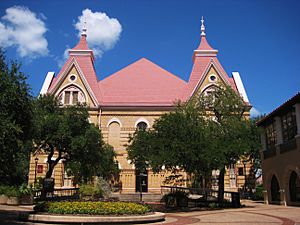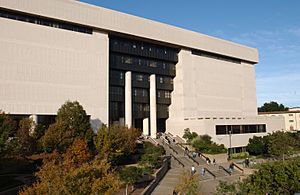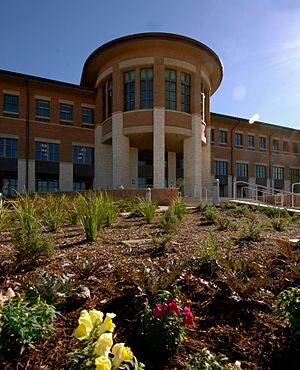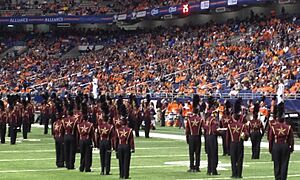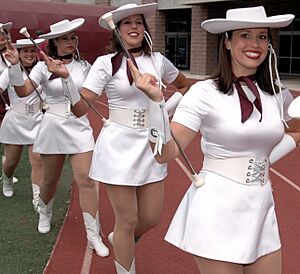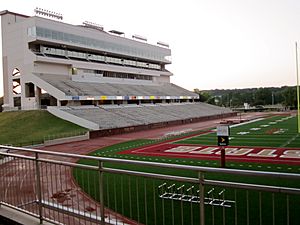Texas State University facts for kids
 |
|
|
Former name
|
Southwest Texas State Normal School (1899–1918) Southwest Texas State Normal College (1918–1923) Southwest Texas State Teachers College (1923–1959) Southwest Texas State College (1959–1969) Southwest Texas State University (1969–2003) Texas State University-San Marcos (2003–2013) |
|---|---|
| Motto | Auctoritas Gravitas Humanitas Veritas (Latin) |
|
Motto in English
|
Prestige, Seriousness, Humanity, Truth |
| Type | Public research university |
| Established | 1899 |
|
Parent institution
|
Texas State University System |
|
Academic affiliations
|
|
| Endowment | $393 million (FY2024) (TXST only) $1.41 billion (FY2024) (system-wide) |
| Budget | $843.06 million (FY2025) |
| President | Kelly Damphousse |
| Provost | Pranesh Aswath |
| Students | 40,678 (fall 2024) |
| Undergraduates | 36,206 (fall 2024) |
| Postgraduates | 4,392 (fall 2024) |
| Location |
,
United States
29°53′20″N 97°56′20″W / 29.88889°N 97.93889°W |
| Campus | 517 acres (209 ha) main campus 101 acres (41 ha) Round Rock campus |
| Colors | Maroon and Gold |
| Nickname | Bobcats |
|
Sporting affiliations
|
NCAA Division I FBS – Sun Belt |
| Mascot | Boko the Bobcat |
 |
|
Texas State University (TXST) is a large public university with its main campus in San Marcos, Texas. It also has another campus in Round Rock. The university started in 1899 and has grown a lot since then. Today, it is the seventh-largest university in Texas. In the fall of 2024, a record 40,678 students were enrolled at Texas State University.
Texas State University offers more than 200 different study programs. These include bachelor's, master's, and doctoral degrees. The university is officially recognized by the Southern Association of Colleges and Schools. It is also known as a Hispanic-Serving Institution (HSI). Texas State is recognized for its high research activity. In the 2024 school year, it spent over $160 million on research projects.
The 36th president of the United States, Lyndon B. Johnson, graduated from Texas State in 1930. Texas State University is the only college in Texas where a U.S. president studied.
The main campus in San Marcos has 259 buildings on 517 acres of hilly land. It is located along the San Marcos River. The university also has a 101-acre campus in Round Rock. Texas State runs the 70-acre Science, Technology and Advanced Research (STAR) Park. This park helps turn new ideas into real products. The university also owns over 4,500 acres of land for recreation, teaching, and farming. The Forensic Anthropology Center at Texas State is the largest facility in the world for studying human remains to help solve crimes.
Texas State University's sports teams are called the Bobcats. They compete in National Collegiate Athletic Association (NCAA) Division I sports. They are part of the Sun Belt Conference.
Contents
History of Texas State University
Texas State University was first suggested in 1899 by state representative Fred Cocke. It was originally called Southwest Texas State Normal School. The main goal of the school was to train future teachers for Texas. Students who earned a diploma and teaching certificate could teach in public schools.
In October 1899, the city of San Marcos gave 11 acres of land for the school. The Texas legislature approved money for buildings in 1901. The first building, now called Old Main, was finished in 1903. The school opened its doors in September 1903 with 303 students.
In 1912, the San Marcos School Board started working with the university. This allowed university students to teach local children as part of their training. In 1917, the San Marcos East End Ward School moved onto the university campus. This partnership continued for many years.
The university welcomed its first African-American students in 1963. This happened after a court decision helped ensure equal access for all students.
On November 8, 1965, former student Lyndon B. Johnson, who was then the U.S. President, returned to the school. He signed the Higher Education Act of 1965 there. This law helped more students afford to go to college. President Johnson shared stories about how he struggled to pay for college himself.
In 1969, some students protested the Vietnam War. They were known as the "San Marcos 10." Their case went through the courts, and they were eventually reinstated.
How the Campus Grew
The campus has grown a lot from its first 11 acres in 1899. In the first 40 years, 18 buildings were added around Old Main. These included classrooms, a library, dorms, and gyms.
In 1994, the university bought the Aquarena Springs theme park property. This land is now used for research and education about water. It still offers educational tours and glass-bottom boat rides.
In 1996, the school started offering classes in Round Rock, Texas. These were mostly night classes for graduate degrees. As more students joined, a new campus was built. The Texas State University Round Rock Campus opened in 2005 on 101 acres of donated land.
Changes to the School's Name
The school's name has changed several times over the years.
- In 1918, it became Southwest Texas State Normal College.
- In 1923, it was renamed Southwest Texas State Teachers College.
- In 1959, it became Southwest Texas State College.
- Ten years later, in 1969, it was renamed Southwest Texas State University.
In 2003, students asked for the name to be changed to Texas State University at San Marcos. They felt the old name sounded too local. The students even offered to pay for the change. On September 1, 2003, the school officially became Texas State University–San Marcos. The city name was added to tell it apart from other schools. However, those other schools did not change their names.
Because the university also grew in Round Rock, the city name was removed. On September 1, 2013, the name officially changed to Texas State University. This was the sixth name change in the school's history.
Exploring the Campus
Texas State University has over 8 million square feet of buildings. Its campuses cover more than 500 acres. There are also over 4,000 acres for farming, research, and recreation.
The main campus is in San Marcos, Texas. It is located between Austin and San Antonio along Interstate 35. The campus includes the original land on Chautauqua Hill, where Old Main stands. The university also runs the 101-acre Round Rock Campus and the 70-acre Science, Technology, and Advanced Research (STAR) Park.
The Quad is a central area on the main campus. Many academic buildings are around it, and most university buses stop nearby. It is a popular spot for student groups to meet and share information. On the west side of the Quad, there is a 17-foot tall aluminum sculpture of two horses called The Fighting Stallions. This area is where students can freely express their ideas. The east side of the Quad goes up to the highest hill on campus, where Old Main is located.
The main campus in San Marcos was used as the setting for the fictional school TMU (Texas Methodist University) in the TV show Friday Night Lights.
Old Main Building
Built in 1903, Old Main was the first building on campus. It was designed in a Victorian Gothic style. The building was added to the National Register of Historic Places in 1983. Over the years, Old Main has been used for many things. It was once the main administration building and an auditorium. Today, it houses offices for the School of Journalism and Mass Communication and the College of Fine Arts and Communication.
Alkek Library
The university's library was named in 1991 after Albert B. Alkek, a former student who became a successful oilman and helper of good causes. The Albert B. Alkek Library is the main library for the university. It has many government documents from the U.S. and Texas. The library also has special collections, including the Wittliff collections. These collections include Mexican photography, archives from the TV show King of the Hill, and works by famous writers like Cormac McCarthy and Sandra Cisneros.
Sewell Park

Sewell Park is on the Texas State University campus, right by the San Marcos River. It opened in 1917 and was first called Riverside Park. Students used it to learn how to swim and for fun. In 1949, the park was renamed Sewell Park to honor S. M. Sewell, a math professor who helped create the park.
A well-known person at Sewell Park is Dan Barry, also called "Frisbee Dan." You can often see him throwing his frisbee and watching over the park on sunny days.
Round Rock Campus
The university's Round Rock Campus (RRC) is located in Round Rock, Texas, about 20 miles north of Austin. It started in 1996 with a few classes in temporary buildings. In 2003, the Avery family donated 101 acres of land for a new campus. The Avery Building opened in August 2005. This building has classrooms, labs, offices, and a library. In 2010, the Nursing Building opened, and a new health professions building, Willow Hall, opened in 2018. A new academic building, Esperanza Hall, began construction in December 2024.
What You Can Study at Round Rock
The Round Rock Campus offers classes for the last two years of bachelor's degrees. It also has graduate degrees and special training programs. Students who finish their studies at the Round Rock Campus earn degrees from Texas State University.
Academics and Learning
Student Body
As of fall 2024, Texas State University had 40,678 students. Most of them, 36,206, are undergraduate students. The university accepted 68% of freshmen who applied for fall 2023. This includes guaranteed acceptance for Texas high school graduates in the top 10% of their class. About 56% of undergraduate students finish their degree in six years.
Texas State is a Hispanic-serving institution. In 2014, Hispanic students made up 32% of the student body. About 60% of students are female. Most students (78%) live off-campus. About 10% of students are part of a fraternity or sorority.
University Rankings
Texas State University has received several awards and recognitions. In 2024, it earned its fourth gold award for supporting veterans in education. The U.S. Department of State also named it a Fulbright Hispanic-Serving Institution Leader. The university is listed among the best colleges by Princeton Review, Wall Street Journal, and Forbes.
In the 2024 U.S. News & World Report rankings, Texas State was tied for 273rd among national universities.
Colleges and Programs
Texas State University offers 99 bachelor's programs, 91 master's programs, and 20 doctoral programs. The university has been officially recognized since 1925.
These programs are offered through nine academic colleges:
- College of Applied Arts
- McCoy College of Business
- College of Education
- College of Fine Arts and Communication
- College of Health Professions
- Honors College
- The Graduate College
- College of Liberal Arts
- College of Science and Engineering
Research at Texas State
In 2012, Texas State University was named an "emerging research university" by the state. To get this title, a university must spend at least $14 million on research. In 2016, Texas State was reclassified as an R2 institution. This is the second-highest level for research universities in the country. The university is working to become an R1 institution by 2027.
Texas State has more than 30 research centers. These include centers for data science, water and the environment, school safety, and music history.
One important facility is the Science, Technology, and Advanced Research (STAR) Park. It focuses on environmental sustainability and biotechnology. The park helps university professors turn their research into new startup companies.
The Forensic Anthropology Center at Texas State is one of only seven places in the U.S. that studies human decomposition. It is the largest such facility in the world.
In 2012, the River Systems Institute was renamed the Meadows Center for Water and the Environment. This happened after a large donation from the Meadows Foundation. The center works to ensure clean water for everyone and the environment.
Professors from Texas State have often received Fulbright Scholar grants. This means Texas State is one of the top universities for producing Fulbright Scholars.
Fun Activities and Groups
Living on Campus
About 20% of Texas State students live in housing on campus or owned by the university. About 88% of first-year students live in university housing. In fall 2024, about 9,042 students lived in dorms or apartment-style housing.
Student Groups and Greek Life
List of Texas State University Greek organizations Texas State University has over 300 student organizations. These include Greek organizations, academic clubs, honor societies, service groups, and sports clubs. There are more than 30 fraternities and sororities. After a sad event in 2017, all Greek life activities were paused. They started again in March 2018 after some changes were made to the system.
Music, Government, and Performance Groups
Bobcat Marching Band
The Bobcat Marching Band is the university's marching band. It is nicknamed "The Pride of the Hill Country." The band started in 1919. It performs at Texas State football games, NFL games, and professional soccer games. The band has also performed at two presidential inaugurations.
Student Government
The school's student government is made up of students who speak for all students to the university leaders. They have worked on issues like carrying concealed weapons on campus and the university's no-smoking policy. Student Government also manages a scholarship fund for Texas State students.
Honor Societies
Many honor societies exist on campus, like Golden Key and the Alpha Chi National College Honor Society. Texas State was one of the first members of Alpha Chi when it started in 1927. The university also has an active chapter of Alpha Phi Omega, a national service fraternity.
Texas State Strutters
The Texas State Strutters are a famous dance team. They were formed in 1960 and were the first of their kind at a four-year university in the U.S. The group performs many dance styles, including high kick, jazz, and hip hop. The Strutters have performed in 26 countries and at major events like two Macy's Thanksgiving Day Parades and America's Got Talent.
The Big Event
The Big Event, previously called Bobcat Build, is a yearly community service event. It started in 2001 and is the largest student-run event at the university. Students and student groups sign up to do service projects around the San Marcos community. The event has been recognized by politicians.
Media and News
The university's newspaper, now called the University Star, started in 1911. It covers news, trends, opinions, and sports for the college. The newspaper is published weekly during the fall and spring semesters. It also has a website with videos, blogs, and podcasts. The Star and its staff have won many awards.
Texas State's FM radio station, KTSW, broadcasts at 89.9 MHz. It provides sports coverage for Texas State Athletics and plays independent music. The KTSW website offers live-streaming. KTSW's morning show, Orange Juice and Biscuits, has won awards and was listed among Austin's top morning radio shows in 2008.
Sports at Texas State
Texas State competes in NCAA Division I sports and is a member of the Sun Belt Conference. Texas State teams and athletes have won national and regional championships. Some athletes have even won medals in the Olympic Games.
Mascot and Logo
In 1920, Texas State chose its first official mascot, the bobcat. Oscar Strahan, the athletic director, suggested the bobcat because it is fierce and lives in central Texas. The bobcat mascot got its name, Boko the Bobcat, in 1964. The athletic logo, called the SuperCat logo, was designed by a student in 2003. In 2009, the Texas State lettering was added to the logo.
Sports Rivalries
Texas State used to have a rivalry with Nicholls State University in football. This rivalry, called the Battle for the Paddle, ended in 2011 when Texas State changed sports conferences.
The rivalry with the University of Texas at San Antonio (UTSA) is called the I-35 Showdown. This is because Interstate Highway 35 connects San Marcos and San Antonio. A trophy shaped like an Interstate 35 sign is given to the winner of sports games between the two schools.
Texas State's only in-state rival in the Sun Belt Conference was the University of Texas at Arlington (UT Arlington). This rivalry continued as both schools moved between conferences. However, in 2022, UT Arlington left the Sun Belt Conference.
Moving to FBS Football
In 2007, the university decided to explore moving its football team to the Football Bowl Subdivision (FBS). This is a higher level of college football. Students voted to approve an increase in fees to help pay for this move. In February 2008, almost 80% of students who voted agreed to raise the athletics fee.
The university also made improvements to its football stadium, Bobcat Stadium. Three phases of construction doubled the stadium's seating capacity to 30,000. They also added luxury boxes and improved the press box.
Famous Former Students
- Notable people
-
Paul Goldschmidt
7-time MLB All-Star -
Robert L. Rutherford
General, United States Air Force -
George Strait
Country music singer -
Ricky Wayne Sanders 2× Super Bowl champion (XXII, XXVI)
Texas State University's most famous former student is U.S. president Lyndon B. Johnson. He attended the university from 1926 to 1930. As a student, Johnson was on the debate team and was an editor for the student newspaper. He is the only U.S. president who graduated from a university in Texas.
Another well-known former student is Grammy Award-winning country music singer George Strait. Strait graduated in 1979 with a degree in agriculture. He performed his first show with the Ace in the Hole Band in San Marcos while he was a student. In 2006, the university gave Strait an honorary degree.
Other notable former students include:
- Comedian Devon Walker, who joined the cast of Saturday Night Live in 2022.
- General Robert L. Rutherford from the United States Air Force.
- Musician Scott H. Biram.
- Actor Powers Boothe.
- Writer Tomás Rivera.
- Columnist "Heloise" (Ponce Cruse Evans).
- Baseball player Paul Goldschmidt for the St. Louis Cardinals.
- Professional wrestler Lance Archer (Lance Hoyt).
- Texas musician Charlie Robison.
See also
 In Spanish: Universidad Estatal de Texas para niños
In Spanish: Universidad Estatal de Texas para niños



